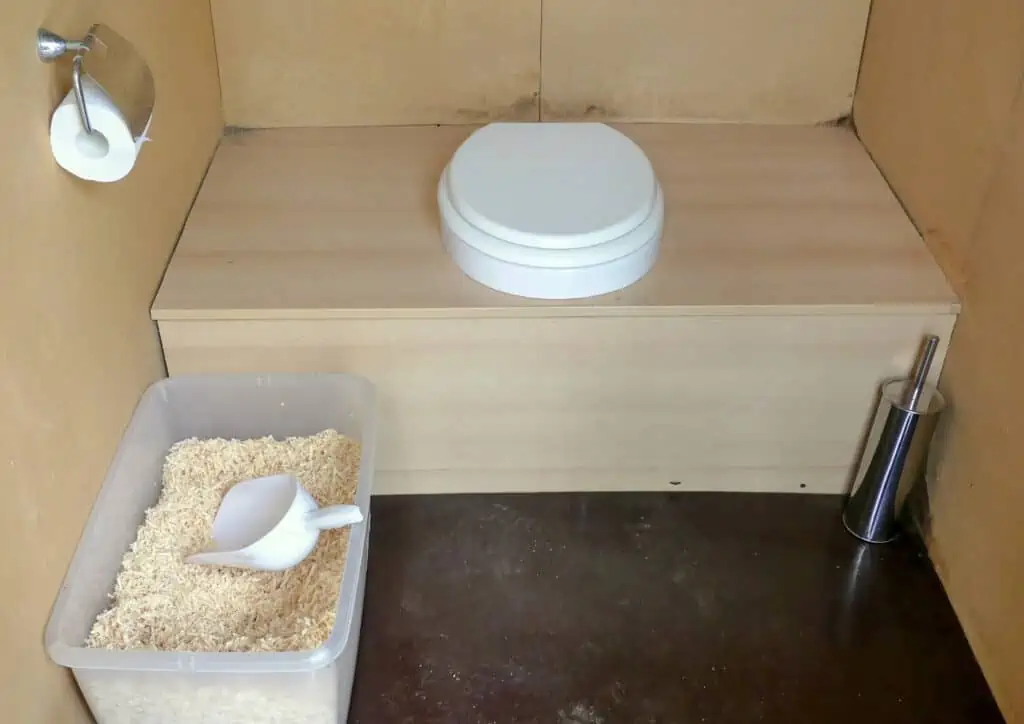As an Amazon Associate I earn from qualifying purchases.
At A Glance
Compost toilets, when managed correctly, should not emit bad odors. They are designed to facilitate aerobic decomposition, which, unlike anaerobic decomposition, does not produce foul smells. Adequate ventilation, proper balancing of “green” and “brown” materials, and regular maintenance are crucial for odor control in composting toilets. Any foul smell is usually a sign of improper management or imbalance in the composting process, such as over-saturation or lack of aeration.
Composting toilets have been gaining popularity in recent years as a more sustainable and eco-friendly alternative to traditional flush toilets. However, many people are hesitant to make the switch because of concerns about odor. So, do composting toilets really stink? The answer is not a simple yes or no, as it depends on several factors.

First and foremost, the design and quality of the composting toilet itself plays a big role in whether or not it will produce odors. High-quality composting toilets are designed to minimize odors, with efficient ventilation and waste separation processes. When properly installed and maintained, a composting toilet should not produce detectable odors. However, if the toilet is not properly installed or maintained, odors can become a problem. Additionally, some lower-quality composting toilets may produce more odors than others.
Another factor to consider is personal preference and tolerance for odors. While some people may not notice any odors from a composting toilet, others may be more sensitive and find even a slight odor unpleasant. It’s important to keep in mind that composting toilets are not completely odor-free, but the odors produced should be minimal and not overpowering. With proper installation, maintenance, and ventilation, a composting toilet should not be a significant source of unpleasant smells in your home or outdoor space.
Understanding Composting Toilets

As someone who is interested in the environmental impact of human waste, you may have heard of composting toilets. Composting toilets are a type of organic toilet that use the natural composting process to break down human waste into organic matter. This process is done without the use of water, making composting toilets an eco-friendly alternative to traditional flush toilets.
Modern composting toilets come in a variety of designs, but they all share a common goal: to turn human waste into compost. When using a composting toilet, solid waste falls into a vented chamber with a removable bucket. Liquid waste drains into a separate container, or outdoors into a cesspool or septic system. Venting of the catchment chamber is crucial to ensure proper aeration and the decomposition of waste.
The composting process begins when human waste enters the composting chamber. The chamber contains a mixture of organic matter and bacteria that break down the waste into compost. This process is called aerobic decomposition, which means that it requires oxygen to work properly. If the composting chamber is not properly vented, anaerobic decomposition can occur, which produces foul odors and can lead to the buildup of harmful gases.
Composting toilets are a great option for those who want to reduce their environmental impact and live a more sustainable lifestyle. They are also a great option for those who live in areas without access to traditional plumbing systems. While composting toilets may not be for everyone, they are a viable option for those who are willing to put in the effort to properly maintain them.
Overall, composting toilets are an eco-friendly and sustainable alternative to traditional flush toilets. By using the natural composting process to break down human waste, composting toilets reduce the amount of water needed to treat waste and prevent the release of harmful chemicals into the environment.
How Composting Toilets Work
Decomposition Process
Composting toilets work by using the natural process of decomposition to break down human waste into usable compost. This process is achieved through the use of oxygen-loving (aerobic) bacteria that break down the organic material in the waste. The bacteria generate heat during the decomposition process, which helps to kill off pathogens and other harmful organisms.
Ventilation System
To keep the decomposition process going, composting toilets require a ventilation system. This system helps to maintain the right balance of oxygen and moisture levels in the waste. Most composting toilets have a vent that pulls air through the toilet and out of the building. This ventilation system helps to prevent the buildup of unpleasant odors.
Waste Separation
Composting toilets typically separate solid waste from liquid waste. Solid waste falls into a catchment chamber where it is mixed with sawdust, straw, or other carbon-rich materials that help to balance the composting process. Liquid waste is typically drained into a separate container or outside into a cesspool or septic system.
Balancing Materials
To ensure that the composting process is effective, it’s important to balance the materials in the toilet. This means adding enough carbon-rich materials like sawdust, straw, or leaves to the solid waste to help absorb moisture and prevent odors. It’s also important to add enough nitrogen-rich materials like urine and toilet paper to help speed up the decomposition process.
Maintenance and Inspection
Like any other type of toilet, composting toilets require regular maintenance and inspection. This includes adding balancing materials, emptying the catchment chamber, and inspecting the ventilation system for blockages or other issues. It’s also important to use natural cleaners and avoid harsh chemicals that can disrupt the composting process.
Use in Different Settings
Composting toilets can be used in a variety of settings, including vans, RVs, tiny homes, boats, and more. They are also a popular choice for eco-friendly homes that want to avoid using septic tanks or waste treatment plants. Composting toilets can be used to recycle waste and create fertilizer for gardens, trees, and other plants.
Costs and Benefits
Composting toilets can be more expensive than traditional toilets, but they offer a number of benefits. They are eco-friendly, reduce water usage, and can be used in areas without access to a sewer system. Composting toilets also produce usable compost that can be used to fertilize plants and gardens.
Do Composting Toilets Smell
One of the primary concerns with composting toilets is odor. While composting toilets can produce a foul smell, this can be managed with proper ventilation and balancing of materials. The use of natural cleaners and regular maintenance can also help to reduce odors.
Managing Odor in Composting Toilets
To manage odor in composting toilets, it’s important to maintain proper ventilation and balance the materials in the toilet. This means regularly adding carbon-rich materials like sawdust, straw, or leaves to the solid waste and nitrogen-rich materials like urine and toilet paper. It’s also important to empty the catchment chamber regularly and inspect the ventilation system for blockages or other issues.
Conclusion
Composting toilets offer a number of benefits, including eco-friendliness and the production of usable compost. While they can produce a foul smell, this can be managed with proper ventilation and balancing of materials. Regular maintenance and inspection are also important to ensure that the toilet is functioning properly.
